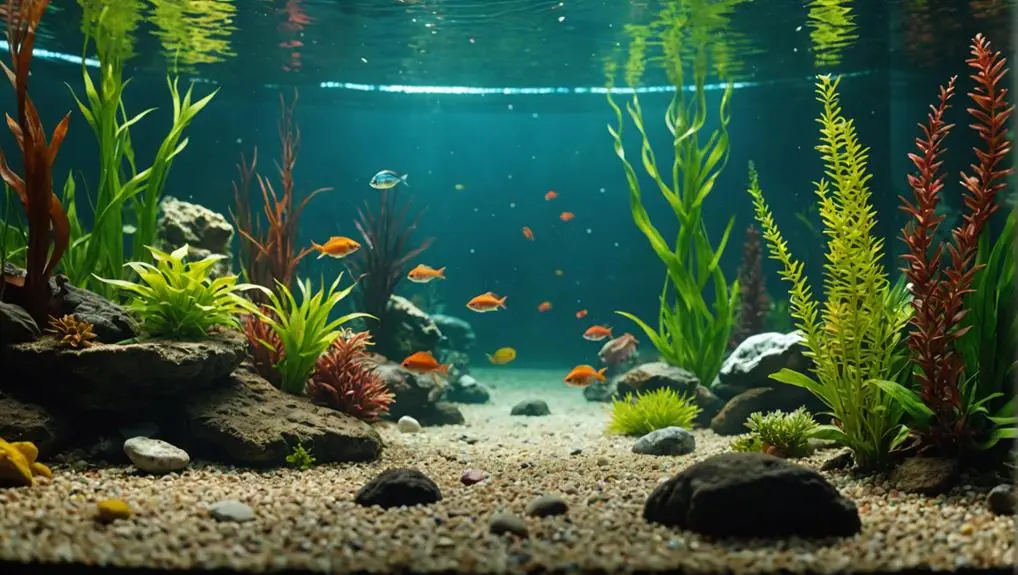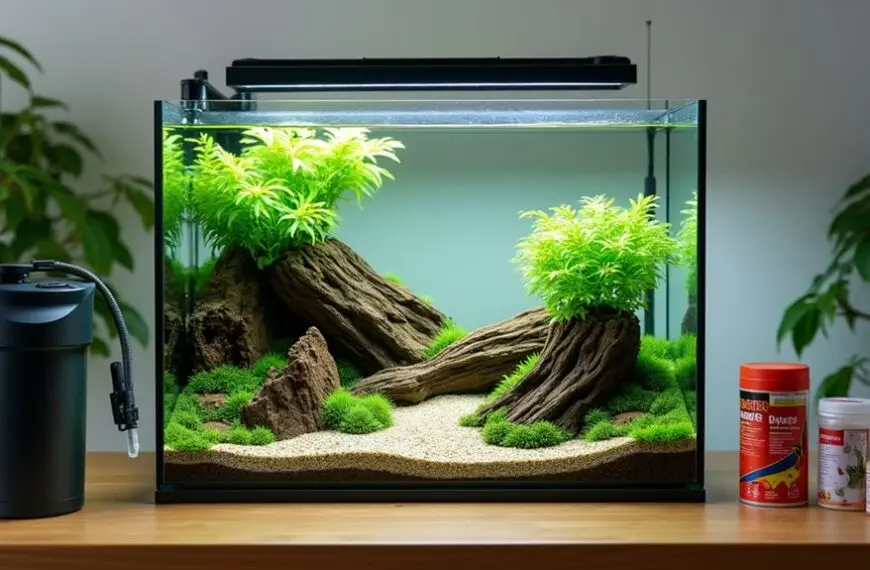Substrate is way more than just a pretty layer in your fish tank; it's like the foundation of a healthy underwater world! It's home to beneficial bacteria that break down waste, which keeps the water clean and your fish happy. Plus, the right substrate supports plant growth, helps with oxygen levels, and can even influence fish behavior. Whether you choose gravel, sand, or nutrient-rich soil, each type can affect your tank's look and function. So, picking the right substrate really matters. Trust me, you wouldn't want your fish swimming in a chaotic mess! Stick around, and you'll uncover more tips!
Contents
- 1 Importance of Substrate in Aquariums
- 2 Types of Substrate Materials
- 3 Functions and Benefits of Substrate
- 4 Selecting the Right Substrate
- 5 Substrate Depth Recommendations
- 6 Common Issues With Substrate
- 7 Substrate Maintenance Practices
- 8 Impact on Fish Behavior
- 9 Frequently Asked Questions
- 10 Final Thoughts
Importance of Substrate in Aquariums
Substrate plays a crucial role in the health and aesthetics of your aquarium. It's not just about making your tank look pretty; it's about creating a thriving environment for your aquatic friends.
The right substrate acts as a home for beneficial bacteria that help break down waste, keeping your water quality top-notch. Good water quality is vital for the health of your fish species and plants, so you want to get this right!
Now, let's talk about aquatic plants. They need a solid foundation for root development, and the depth of your substrate matters. For non-planted tanks, 2 inches is fine, but if you're going all out with plants, aim for 3-6 inches. This depth allows for better nutrient availability, which is crucial for their growth.
Plus, watch out for how different substrates can affect water chemistry. Some materials, like crushed coral, can change pH levels, which mightn't be ideal for every fish species.
Types of Substrate Materials
Choosing the right substrate material can significantly impact the overall health and appearance of your aquarium. You've got options!
Standard gravel is a popular choice, available in various sizes and colors, making it versatile for many setups. If you have burrowing fish species, aquarium sand might be your best bet. Its fine texture allows them to dig and act naturally, which is a joy to watch.
For those with a green thumb, nutrient-rich soil is fantastic for plant growth. It provides the essential nutrients your plants need while supporting a robust root system.
If you're caring for fish that prefer a higher pH, crushed coral substrate is ideal. It raises the pH and buffers the water, creating a comfy environment for those specific fish types.
Oh, and let's not forget marbles! They're not just for playing; they can be a practical choice for breeding egg-scattering fish. Their smooth surfaces make maintenance easy and offer a safe spot for developing eggs.
With all these options, you can create the perfect home for your aquatic friends! Your choice of substrate truly matters in serving your fish and plants well.
Functions and Benefits of Substrate
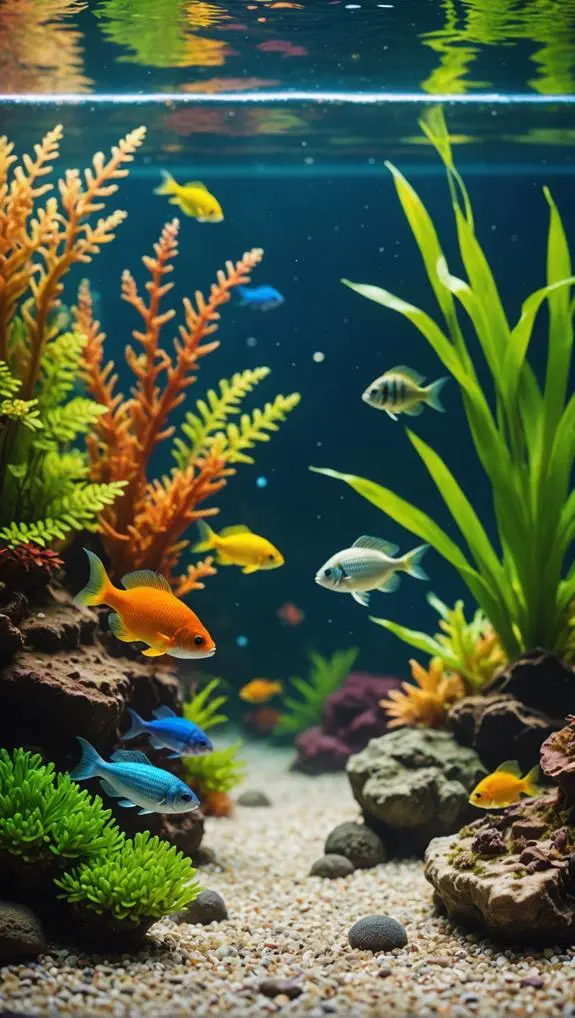
A well-selected substrate plays a crucial role in the health and functionality of your aquarium.
It's not just about looks; the right substrate can make all the difference in creating a thriving underwater world. Here are three key functions and benefits:
1. Supports Beneficial Bacteria: Your substrate acts as a home for beneficial bacteria that help with the nitrogen cycle. This is essential for breaking down waste and keeping your water quality high.
2. Promotes Plant Growth: If you're keen on keeping aquatic plants, a nutritious substrate provides a stable anchor and essential nutrients, helping them flourish.
Healthy plants improve oxygen levels and create a balanced ecosystem.
3. Enhances Visual Appeal: With so many colors and textures available, you can choose a substrate that complements your decor and showcases your fish species beautifully, making your tank a visual delight.
Selecting the Right Substrate
How do you ensure that your fish tank substrate meets the specific needs of your aquatic life?
Selecting the right substrate is crucial for your fish and plants. Different species have unique requirements, especially when it comes to breeding and growing roots. For instance, some fish prefer sandy bottoms for foraging, while plants thrive in nutrient-rich soils.
You'll also want to consider water chemistry. Some substrates, like crushed coral, can raise pH levels, impacting your fish's health. Aesthetic choices matter too! The right colors and textures can enhance your tank's beauty while providing habitats for bottom-dwellers.
Depth is another factor to keep in mind. For non-plant tanks, a 2-inch depth works well, but if you're going green with plants, aim for 3 to 6 inches to support healthy root systems.
Maintenance can vary; inert gravel might need extra fertilization, while organic options may require regular checks for nutrient levels.
Substrate Depth Recommendations
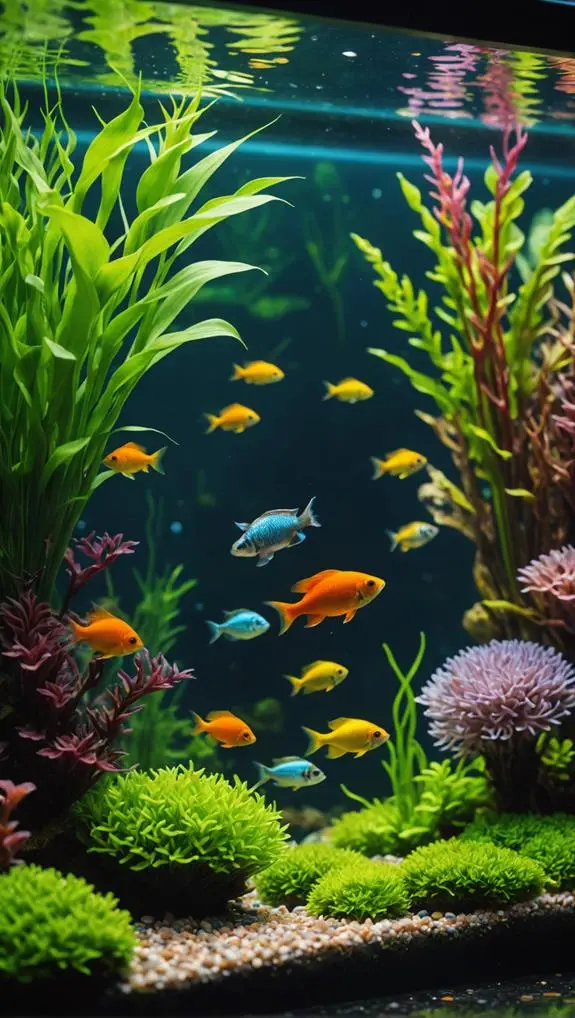
When setting up your fish tank, getting the right substrate depth is super important.
For non-plant tanks, aim for about 2 inches, while if you're going for a plant paradise, 3 to 6 inches will do the trick.
Just remember, too much substrate can turn your tank into an underwater gas chamber, so keep an eye on those depths!
Recommended Depth Guidelines
Considering the needs of your fish tank, substrate depth plays a crucial role in maintaining a healthy environment.
Choosing the right depth not only aids in plant growth but also keeps your water quality in check. Here are some recommended guidelines to help you out:
- Non-plant tanks: Aim for a substrate depth of about 2 inches. This depth makes maintenance easier and helps maintain water quality without the risk of debris buildup.
- Moderate to heavy plant growth: Go for a depth of 3 to 6 inches. This supports root systems and enhances nutrient availability, giving your plants the best chance to thrive.
- Regular maintenance: Pair your cleaning routine with water changes, ideally once or twice a month. This prevents debris buildup and keeps the substrate healthy.
Excessive Depth Issues
Excessive substrate depth can create significant problems in your fish tank, particularly by fostering anaerobic zones that produce harmful gases. If your substrate is too deep, it can lead to a buildup of these gases, which can seriously harm your fish health.
You want your tank to be a thriving haven, not a toxic wasteland!
The recommended substrate depth for non-plant tanks is about 2 inches. For those of you with a green thumb, aiming for 3-6 inches for plants is ideal. This depth gives roots room to grow while still keeping things balanced.
Plus, beneficial bacteria love a balanced substrate. They help with the nitrogen cycle, breaking down waste and keeping your tank clean.
Don't forget about regular cleaning! Using a substrate vacuum helps prevent the accumulation of debris that can worsen those anaerobic zones.
Think of it as a spa day for your fish tank—your aquatic friends will thank you! By maintaining a well-managed substrate depth, you're ensuring a happy, healthy environment for your fish, and isn't that what it's all about?
Common Issues With Substrate
Substrate issues can significantly impact the health and aesthetics of your aquarium. If you want a thriving aquatic environment, it's crucial to recognize these common problems.
- Algae Growth: Excessive lighting and nutrient imbalances can lead to pesky algae blooms. This not only affects your water quality but also harms plant health.
- Compaction: When your substrate gets compacted, it stunts root growth for aquatic plants. If you ignore this, your plants mightn't get the nutrients they need and could eventually decay—yikes!
- Toxic Buildup: Decomposing organic matter in the substrate can release harmful substances into the water. This toxic buildup can endanger your fish and other aquatic friends.
Additionally, uneven distribution can hurt aesthetic quality and affect bottom-dwellers who rely on the substrate.
Plus, some substrates may invite unwanted organisms or pests that can lead to infestations, complicating your tank's ecosystem.
Keeping an eye on these issues helps ensure your aquarium remains a beautiful, healthy haven for your aquatic life. After all, a happy tank means happy fish!
Substrate Maintenance Practices
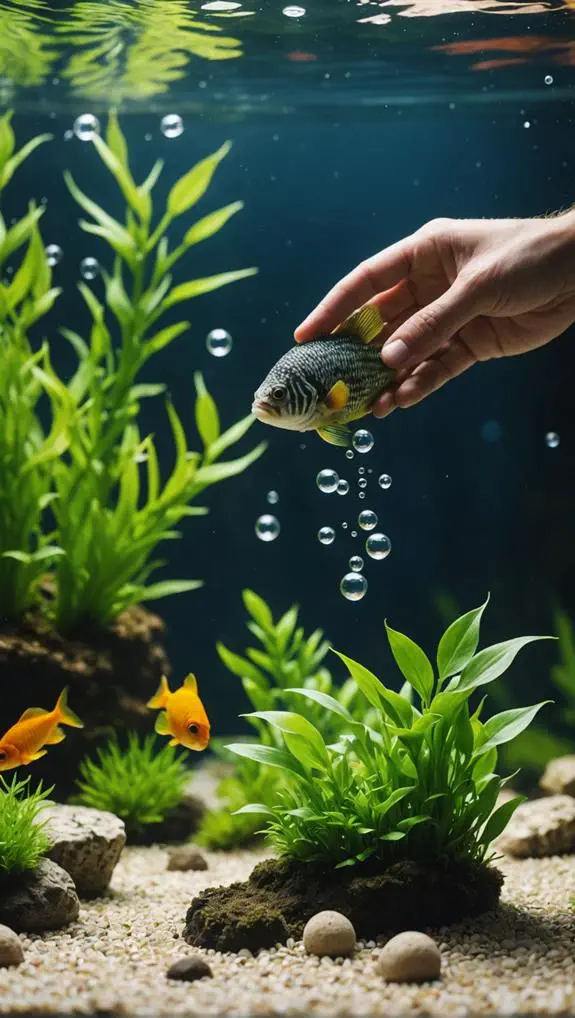
To keep your aquarium thriving, regular substrate maintenance is essential. Think of it as giving your aquatic friends a clean home to flourish in.
Using a gravel vacuum once or twice a month helps remove waste and debris from the substrate without disturbing it too much, preventing harmful buildup that can mess with water quality. Pair this with routine water changes to maintain a healthy environment for your aquatic life.
Monitoring substrate depth is also crucial. Aim for about 2 inches in non-plant tanks and 3-6 inches for heavily planted setups. This depth ensures optimal conditions for root growth and nutrient availability.
But don't forget to check for compaction! If the substrate gets too compacted, it can hinder root growth, so occasionally disturbing it allows for better aeration and nutrient flow.
Impact on Fish Behavior
In an aquarium, the choice of substrate plays a crucial role in shaping fish behavior. You mightn't realize it, but the substrate you select can transform your tank into a thriving ecosystem.
Here are three key impacts to consider:
- Hiding Spots: Soft substrates like sand offer bottom-dwelling species, such as catfish, a cozy place to burrow and forage. This reduces stress, allowing shy fish to feel secure.
- Spawning Behaviors: Certain fish, like cichlids, need specific substrates to lay their eggs. If you want to encourage breeding, choosing the right substrate can be a game-changer for their reproductive success.
- Visual Behavior: The texture and color of the substrate can affect how fish interact visually. Bright, contrasting colors can enhance mating displays and influence territorial engagements, making your tank more lively.
Frequently Asked Questions
How Important Is Substrate in an Aquarium?
Substrate in your fish tank is crucial. It impacts substrate types, depth, and colors, supporting substrate bacteria and aquatic plants. Proper substrate maintenance and layering enhance visual appeal while providing essential substrate benefits for a thriving ecosystem.
Is It OK to Have No Substrate in Aquarium?
You can have no substrate in your aquarium, but consider how it affects fish health and plant growth. Explore aquascaping ideas and maintenance tips for bare bottom tanks, while ensuring cleaning methods support a healthy environment.
Why Is Substrate Important?
Substrate's vital—it's the heart of your aquarium! Choosing the right substrate types, depth, and materials influences aesthetics, supports beneficial substrate bacteria, aids substrate filtration, and enhances substrate plants' growth, ultimately ensuring thriving aquatic life.
What Is the Best Substrate to Use in a Fish Tank?
Choosing the best substrate involves considering gravel types, sand options, and your budget materials. Layering substrates can enhance aesthetics and health in planted tanks. Keep substrate depth in mind and monitor pH effects for optimal fish care.
Final Thoughts
So, next time you're setting up your fish tank, remember, substrate isn't just a fancy word for "gravel." It's the stage where your aquatic drama unfolds! Whether you're going for a sleek sand beach vibe or a lush jungle floor, the right substrate makes all the difference. It keeps your fish happy, plants thriving, and even gives that nosy snail a cozy home. In the end, a happy fish is a swimming fish—who doesn't want that?

